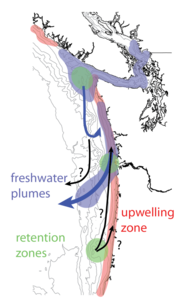
sketch of the PNW modeling region with important transport process that influence harmful algal blooms
transport of harmful algal blooms to the coast SEE MORE HERE at the project website!
Transport of harmful algal blooms (HABs) to the coast in the Pacific Northwest (PNW) pose a threat to human health through bioaccumulation of toxins in organisms such as razor clams and lead to negative monetary impacts on coastal communities due to beach closures. My Postdoctoral research is part of the NSF and NOAA funded Pacific NorthWest TOXins (PNWTOX) project investigating the formation and transport of harmful algal blooms in the PNW.
Within the modeling framework established by my postdoctoral advisor Dr. MacCready, Modeling of the Salish Sea (MoSSea) and the UW Coastal Modeling Group, I have developed numerical hindcast simulations utilizing the Regional Ocean Modeling System (ROMS) of the Salish Sea and Columbia River estuaries and the coastal ocean off of the Washington and Oregon coasts. I have employed particle-tracking experiments to investigate transport pathways between known regions of HAB formation and the coast. We have found that the model is able to predict bloom events at the coast and I am currently investigating the mechanisms driving these events, including wind-driven circulation, interactions with river plumes, and interactions with estuarine exchange flow.
For more information on this project and related projects see:
- Pacficic NorthWest TOXins simulations (PNWTOX simulations)
- Ecology and Oceanography of Harmful Algal Blooms program in the Pacific NorthWest (ECOHAB PNW)
- River Influences on Shelf Ecosystems project (RISE)
